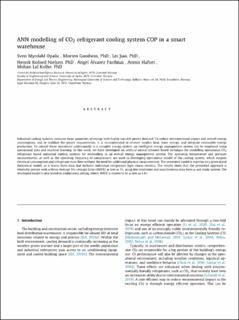| dc.contributor.author | Opalic, Sven Myrdahl | |
| dc.contributor.author | Goodwin, Morten | |
| dc.contributor.author | Lei, Jiao | |
| dc.contributor.author | Nielsen, Henrik Kofoed | |
| dc.contributor.author | Pardiñas, Ángel Á. | |
| dc.contributor.author | Hafner, Armin | |
| dc.contributor.author | Kolhe, Mohan Lal | |
| dc.date.accessioned | 2020-04-02T08:06:49Z | |
| dc.date.available | 2020-04-02T08:06:49Z | |
| dc.date.created | 2020-03-23T11:36:18Z | |
| dc.date.issued | 2020 | |
| dc.identifier.citation | Journal of Cleaner Production. 2020, 260 1-10. | en_US |
| dc.identifier.issn | 0959-6526 | |
| dc.identifier.uri | https://hdl.handle.net/11250/2650006 | |
| dc.description.abstract | Industrial cooling systems consume large quantities of energy with highly variable power demand. To reduce environmental impact and overall energy consumption, and to stabilize the power requirements, it is recommended to recover surplus heat, store energy, and integrate renewable energy production. To control these operations continuously in a complex energy system, an intelligent energy management system can be employed using operational data and machine learning. In this work, we have developed an artificial neural network based technique for modelling operational CO2 refrigerant based industrial cooling systems for embedding in an overall energy management system. The operating temperature and pressure measurements, as well as the operating frequency of compressors, are used in developing operational model of the cooling system, which outputs electrical consumption and refrigerant mass flow without the need for additional physical measurements. The presented model is superior to a generalized theoretical model, as it learns from data that includes individual compressor type characteristics. The results show that the presented approach is relatively precise with a Mean Average Percentage Error (MAPE) as low as 5%, using low resolution and asynchronous data from a case study system. The developed model is also tested in a laboratory setting, where MAPE is shown to be as low as 1.8%. | en_US |
| dc.language.iso | eng | en_US |
| dc.publisher | Elsevier | en_US |
| dc.rights | Attribution-NonCommercial-NoDerivatives 4.0 Internasjonal | * |
| dc.rights.uri | http://creativecommons.org/licenses/by-nc-nd/4.0/deed.no | * |
| dc.title | ANN modelling of CO2 refrigerant cooling system COP in a smart warehouse | en_US |
| dc.type | Peer reviewed | en_US |
| dc.type | Journal article | en_US |
| dc.description.version | acceptedVersion | en_US |
| dc.source.pagenumber | 1-10 | en_US |
| dc.source.volume | 260 | en_US |
| dc.source.journal | Journal of Cleaner Production | en_US |
| dc.identifier.doi | https://doi.org/10.1016/j.jclepro.2020.120887 | |
| dc.identifier.cristin | 1802939 | |
| dc.description.localcode | © 2020. This is the authors’ accepted and refereed manuscript to the article. Locked until 18 March 2022 due to copyright restrictions. This manuscript version is made available under the CC-BY-NC-ND 4.0 license http://creativecommons.org/licenses/by-nc-nd/4.0/ | en_US |
| cristin.ispublished | true | |
| cristin.fulltext | original | |
| cristin.qualitycode | 2 | |

